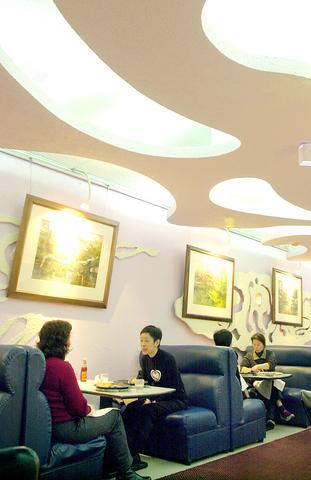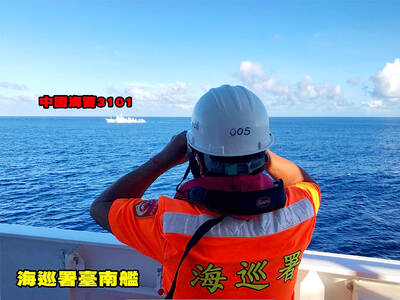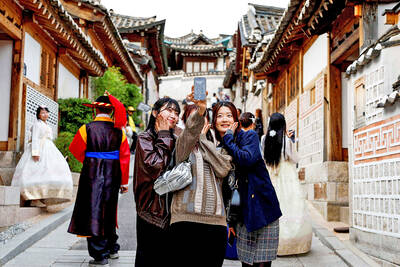Near the intersection of Taipei's Yenping North Road and Minsheng West Road, Bolero restaurant is a reflection of the once-vibrant Tataocheng (
Bolero enjoys a huge reputation; when Taipei residents are asked about the restaurant, most have heard of it and some remember it as a matchmaking hub.
But like the character Norma Desmond in Sunset Boulevard, Bolero and Tataocheng's heydays have passed.

PHOTO: CHIANG YING-YING, TAIPEI TIMES
The Bolero restaurant opened in 1934, and it was the top western-style diner in the 1950s and 1960s. But no one would recommend it as a top-class place to go anymore, although the restaurant still does good business.
"Twenty-five years ago, Bolero was still the leading restaurant in Taipei, doing even better than five-star hotels. There was no competition," restaurant manager Liao Tsung-chi (廖聰麒), who has worked there since 1967, said proudly.
"Bolero was not a restaurant for ordinary folks because of the prices, and people who came were always well-dressed and talked in low voices. Restaurants in major hotels would also send their people to us to learn about the business," he said.
Liao said that the restaurant used to host top businessmen, such as Formosa Plastics Group chairman Wang Yung-ching (王永慶).
"He doesn't come here anymore since it's difficult for a famous person to show up in a public place and not be recognized and bothered by others. But his third wife still dines here every now and then," Liao said.
Shipping tycoon Chang Yung-fa (
Even the so-called tang wai ("outside the party,"
Liao said that Huang Hsin-chieh (
"But of course these days young people have other choices, and the restaurant has become more a place for reminiscing," Liao said.
Indeed, with its slightly weathered exterior, plain white-and-blue billboard and unstylish blue sofa, Bolero has no visible glam to attract the young anymore.
Liao said that the restaurant now mostly hosts regular customers, and these customers often bring their relations.
"Now whenever I go to the restaurant, it's more for a taste of the past," said Yiu Chi-cheng (
Originally there was only one Bolero, but founder Liao Shui-lai (
"But both Boleros are well-known restaurants and popular matchmaking places," Yiu said.
And it is not just the restaurant that has a long history, its employees do too. Liao has worked there for more than 30 years, and 25-year-old waiter Lin Po-chi (
"Business is not as good as before with the economy slowing in recent years," Lin said.
Liao said that his experience in the restaurant proved to him the validity of the Taiwanese proverb, "Wealth can last no more than three generations."
"Sometimes I would see that certain customers or their descendents stop coming because they cannot afford to dine here any-more," Liao said.
Buildings similar to the one Bolero occupies are everywhere in the area of Tihua Street, made famous for its candies, snacks and food for the Lunar New Year holidays.
Most buildings are only three or four floors high, and the color of red bricks has faded, the white walls grayed.
Yet many buildings are also adorned with delicate engravings that cannot be seen on more modern constructions.
Tihua Street and Yenping North Road are a part of Tataocheng, a huge area along Tamshui River to the northwest of Taipei Main Station.
Tataocheng used to be Taipei's economic center before Japan's defeat in World War II, but now it is considered part of old Taipei.
Many famous local entrepre-neurs based their businesses in that area. Both Straits Exchange Foundation Chairman Koo Chen-fu's (辜振甫) father, Koo Hsien-jung (辜顯榮), and Shinkong (新光) Group founder Wu Ho-shih (吳火獅) were respected tea merchants, while China Development chairwoman Diana Chen's (陳敏薰) family was in the textile business in the area.
"Tataocheng is a noble part of the past," said Tu Nien-ru (杜念魯), a 30-year-old Taipei resident. "But then again, Tihua Street is probably the only place in Taipei that can allow people to celebrate the Lunar New Year properly with its New Year goodies.
"The glory may be gone, but the area is a cultural treasure," Tu said.
"When you walk around that area, you do get the feeling of a rich tradition," he said.

The first two F-16V Bock 70 jets purchased from the US are expected to arrive in Taiwan around Double Ten National Day, which is on Oct. 10, a military source said yesterday. Of the 66 F-16V Block 70 jets purchased from the US, the first completed production in March, the source said, adding that since then three jets have been produced per month. Although there were reports of engine defects, the issue has been resolved, they said. After the jets arrive in Taiwan, they must first pass testing by the air force before they would officially become Taiwan’s property, they said. The air force

The Coast Guard Administration (CGA) yesterday said it had deployed patrol vessels to expel a China Coast Guard ship and a Chinese fishing boat near Pratas Island (Dongsha Island, 東沙群島) in the South China Sea. The China Coast Guard vessel was 28 nautical miles (52km) northeast of Pratas at 6:15am on Thursday, approaching the island’s restricted waters, which extend 24 nautical miles from its shoreline, the CGA’s Dongsha-Nansha Branch said in a statement. The Tainan, a 2,000-tonne cutter, was deployed by the CGA to shadow the Chinese ship, which left the area at 2:39pm on Friday, the statement said. At 6:31pm on Friday,

The Chinese People’s Liberation Army Navy’s (PLAN) third aircraft carrier, the Fujian, would pose a steep challenge to Taiwan’s ability to defend itself against a full-scale invasion, a defense expert said yesterday. Institute of National Defense and Security Research analyst Chieh Chung (揭仲) made the comment hours after the PLAN confirmed the carrier recently passed through the Taiwan Strait to conduct “scientific research tests and training missions” in the South China Sea. China has two carriers in operation — the Liaoning and the Shandong — with the Fujian undergoing sea trials. Although the PLAN needs time to train the Fujian’s air wing and

STRIKE: Some travel agencies in Taiwan said that they were aware of the situation in South Korea, and that group tours to the country were proceeding as planned A planned strike by airport personnel in South Korea has not affected group tours to the country from Taiwan, travel agencies said yesterday. They added that they were closely monitoring the situation. Personnel at 15 airports, including Seoul’s Incheon and Gimpo airports, are to go on strike. They announced at a news conference on Tuesday that the strike would begin on Friday next week and continue until the Mid-Autumn Festival next month. Some travel agencies in Taiwan, including Cola Tour, Lion Travel, SET Tour and ezTravel, said that they were aware of the situation in South Korea, and that group